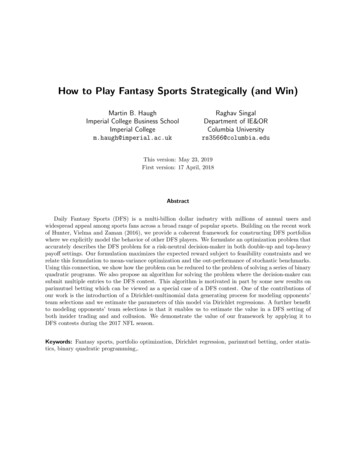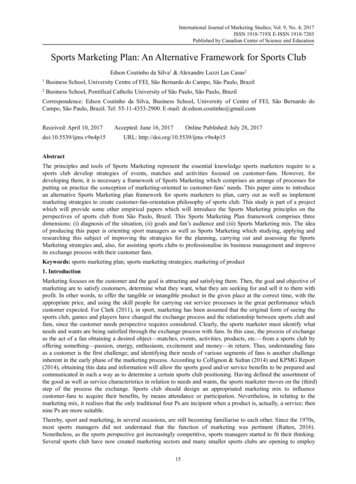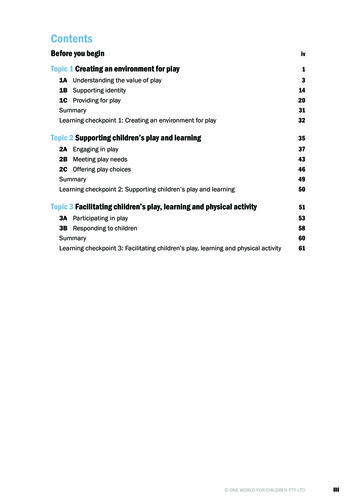
Transcription
How to Play Fantasy Sports Strategically (and Win)Martin B. HaughImperial College Business SchoolImperial Collegem.haugh@imperial.ac.ukRaghav SingalDepartment of IE&ORColumbia Universityrs3566@columbia.eduThis version: May 23, 2019First version: 17 April, 2018AbstractDaily Fantasy Sports (DFS) is a multi-billion dollar industry with millions of annual users andwidespread appeal among sports fans across a broad range of popular sports. Building on the recent workof Hunter, Vielma and Zaman (2016), we provide a coherent framework for constructing DFS portfolioswhere we explicitly model the behavior of other DFS players. We formulate an optimization problem thataccurately describes the DFS problem for a risk-neutral decision-maker in both double-up and top-heavypayoff settings. Our formulation maximizes the expected reward subject to feasibility constraints and werelate this formulation to mean-variance optimization and the out-performance of stochastic benchmarks.Using this connection, we show how the problem can be reduced to the problem of solving a series of binaryquadratic programs. We also propose an algorithm for solving the problem where the decision-maker cansubmit multiple entries to the DFS contest. This algorithm is motivated in part by some new results onparimutuel betting which can be viewed as a special case of a DFS contest. One of the contributions ofour work is the introduction of a Dirichlet-multinomial data generating process for modeling opponents’team selections and we estimate the parameters of this model via Dirichlet regressions. A further benefitto modeling opponents’ team selections is that it enables us to estimate the value in a DFS setting ofboth insider trading and and collusion. We demonstrate the value of our framework by applying it toDFS contests during the 2017 NFL season.Keywords: Fantasy sports, portfolio optimization, Dirichlet regression, parimutuel betting, order statistics, binary quadratic programming,.
1. IntroductionDaily Fantasy Sports (DFS) has become a multi-billion dollar industry [1, 25, 32, 40, 42] with millions ofannual users [17, 40]. The pervasiveness of fantasy sports in modern popular culture is reflected by theregular appearance of articles discussing fantasy sports issues in the mainstream media. Moreover, majorindustry developments and scandals are now capable of making headline news as evidenced [13, 23] in Figures1(a) and 1(b) below. The two major DFS websites are FanDuel and DraftKings and together they controlapproximately 95% of the U.S. market [25, 32]. Approximately 80% of DFS players have been classifiedas minnows [34] as they are not believed to use sophisticated techniques for decision-making and portfolioconstruction. Accordingly, these users provide financial opportunities to the so-called sharks who do usesophisticated techniques [21, 28, 34, 41] when constructing their fantasy sports portfolios. The goal of thispaper is to provide a coherent framework for constructing fantasy sports portfolios where we explicitly modelthe behavior of other DFS players. Our approach is therefore strategic and to the best of our knowledge,we are the first academic work to develop such an approach in the context of fantasy sports.The number of competitors in a typical DFS contest might range from two to hundreds of thousandswith each competitor constructing a fantasy team of real-world athletes, e.g. National Football League(NFL) players in a fantasy football contest, with each portfolio being subject to budget and possibly otherconstraints. The performance of each portfolio is determined by the performances of the real-world athletesin a series of actual games, e.g. the series of NFL games in a given week. The competitors with the bestperforming entries then earn a monetary reward, which depends on the specific payoff structure, e.g. doubleup or top-heavy, of1 the DFS contest.Several papers have already been written on the topic of fantasy sports. For example, Fry, Lundberg,and Ohlmann [16] and Becker and Sun [5] develop models for season-long fantasy contests while Bergmanand Imbrogno [6] propose strategies for the survivor pool contest, which is also a season long event. Multiplepapers have been written of course on so-called office pools (which pre-date fantasy sports contests) wherethe goal is to predict the maximum number of game winners in an upcoming elimination tournament such asthe March Madness college basketball tournament. Examples of this work include Kaplan and Garstka [24]and Clair and Letscher [9]. There has been relatively little work, however, on the problem of constructingportfolios for daily fantasy sports. One notable exception is the recent work of Hunter et al. [22], whichis closest to the work we present in this paper. They consider a winner-takes-all payoff structure andaim to maximize the probability that one of their portfolios (out of a total of N ) wins. Their approachis a greedy heuristic that maximizes their portfolio means, that is, expected number of fantasy points,subject to constraints that lower bound their portfolio variances and upper bound their inter-portfoliocorrelations. Technically, their framework requires the solution of linear integer programs and they applytheir methodology to fantasy sports contests which are top-heavy in their payoff structure as opposed towinner-takes-all. Their work has received considerable attention, e.g. [11], and the authors report earning2significant sums in real fantasy sports contests based on the National Hockey League (NHL) and MajorLeague Baseball (MLB).There are several directions for potential improvement, however, and they are the focus of the workin this paper. First, Hunter et al. [22] do not consider their opponents’ behavior. In particular, they donot account for the fact that the payoff thresholds are stochastic and depend on both the performances ofthe real-world athletes as well as the unknown team selections of their fellow fantasy sports competitors.Second, their framework is only suitable for contests with the top-heavy payoff structure and is in general notsuitable for the double-up payoff structure. Third, their approach is based on (approximately) optimizing forthe winner-takes-all payoff, which is only a rough approximation to the top-heavy contests they ultimately1Loosely speaking, in a double-up contest a player doubles her money if her entry is among the top 50% of submitted entries.In a top-heavy contest, the rewards are skewed towards the very best performing entries and often decrease rapidly in the rankof the entry. See Section 2 for further details.2They donated their earnings to charity and we have done likewise with our earnings from playing DFS competitions duringthe 2017 NFL season. The results of these real-world numerical experiments are described in Section 6.1
(a) New York Times headline, 5 October 2015(b) NBC News headline, 3 August 2016Figure 1: Fantasy sports in the news.target. In contrast, we directly model the true payoff structure (top-heavy or double-up) and seek to optimizeour portfolios with this objective in mind.Our work makes several contributions to the DFS literature. First, we formulate an optimization problemthat accurately describes the DFS problem for a risk-neutral decision-maker in both double-up and top-heavysettings. Our formulation seeks to maximize the expected reward subject to portfolio feasibility constraintsand we explicitly account for our opponents’ unknown portfolio choices in our formulation. Second, weconnect our problem formulation to the finance literature on mean-variance optimization and in particular,the mean-variance literature on outperforming stochastic benchmarks. Using this connection, we show howour problems can be reduced (via some simple assumptions and results from the theory of order statistics)to the problem of solving a series of binary quadratic programs. The third contribution of our work is theintroduction of a Dirichlet-multinomial data generating process for modeling opponents’ team selections. Weestimate the parameters of this model via Dirichlet regressions and we demonstrate its value in predictingopponents’ portfolio choices.We also propose a greedy algorithm for solving the top-heavy problem where the decision-maker cansubmit multiple entries to the DFS contest. This algorithm is motivated by some new results for theoptimization of wagers in a parimutuel contest which can be viewed as a special case of a DFS contest albeitwith some important differences. Parimutuel betting in the horse-racing industry has long been a topic ofindependent interest in its own right, particularly in economics [4, 33, 39, 43], where it has been used totest theories related to market efficiency and information aggregation. We develop a greedy algorithm thatis optimal for the parimutuel contest and use this to motivate a similar algorithm for the more complexDFS contests. We also show the DFS objective function for the top-heavy problem with multiple entriesis monotone submodular, which enables us to invoke a classic result [30] on submodular maximization toprovide further support for our algorithm.We demonstrate the value of our framework by applying it to both double-up and top-heavy DFS contestsin the 2017 NFL season. Despite the fact that DFS contests have a negative net present value (NPV) onaverage (due to the substantial cut taken by the major DFS websites), we succeeded in earning a net profitover the course of the season. That said, model performance in DFS contests based on a single NFL season2
has an inherently high variance and so it is difficult to draw meaningful empirical conclusions from just oneNFL season. Indeed other sports (baseball, ice hockey, basketball etc.) should have a much lower varianceand we believe our approach is particularly suited to these sports.We also use our model to estimate the value of “insider trading”, where an insider, e.g. an employee ofthe DFS contest organizers, gets to see information on opponents’ portfolio choices before making his ownteam selections. This has been a topic of considerable recent media interest [12, 13]; see also Figure 1(a),which refers to the case of a DraftKings employee using data from DraftKings contests to enter a FanDuelDFS contest in the same week and win 350,000. This problem of insider trading is of course also related tothe well known value-of-information concept from decision analysis. While insider trading does result in anincrease in expected profits, the benefits of insider trading are mitigated by superior modeling of opponents’team selections. This is not surprising: if we can accurately predict the distribution of opponents’ teamselection, then insider information will become less and less valuable.It is also straightforward in our framework to study the benefits of a stylized form of collusion in DFScontests. Specifically, we consider the case where a number Ncollude of DFS players combine to constructa single portfolio of Ncollude Emax entries for a given contest, where Emax is the maximum number ofpermitted entries per DFS player. In contrast, we assume that non-colluders choose identical portfolios ofEmax entries. We show the benefits of this type of collusion can be surprisingly large in top-heavy contests.This benefit is actually twofold in that colluding can simultaneously result in a significant increase in thetotal expected payoff and a significant reduction in the downside risk of the payoff. In practice, however, it’shighly unlikely that non-colluding players will choose identical portfolios and so we argue that the benefitsof collusion to a risk-neutral player are likely to be quite small.Beyond proposing a modeling framework for identifying how to construct DFS portfolios, our work alsohas other implications. To begin with, it should be clear from our general problem formulation and solutionapproach that high levels of “skill” are required to play fantasy sports successfully. But this is not necessarilyin the interest of the fantasy sports industry. In order to maintain popular interest (and resulting profitmargins), the industry does not want the role of skill to be too great. Indeed a recent report from McKinsey& Company [26] on fantasy sports makes precisely this point arguing, for example, that chess is a high-skilland deterministic game, which is why it is rarely played for money. In contrast, while clearly a game of highskill, poker also has a high degree of randomness to the point that amateur players often beat professionalsin poker tournaments. It is not surprising then that poker is very popular and typically played for money.The framework we have developed in this paper can be used by the fantasy sports industry to determinewhether the current DFS game structures achieve a suitable balance between luck and skill. One simple“lever” to adjust this balance, for example, would be to control the amount of data they release regardingthe teams selected by the DFS players. By choosing to release no information whatsoever, it will becomemore difficult for skillful players to estimate their models and take advantage of their superior modelingskills. The industry can also use (as we do) our framework to estimate the value of insider trading andcollusion and propose new rules / regulations or payoff structures to counter these concerns.A recent relevant development occurred in May 2018 when the U.S. Supreme Court struck down a 1992federal law – the Professional and Amateur Sports Protection Act – that prohibited states from authorizingsports gambling. As a result, some states are taking advantage of this ruling by passing their own sportsbetting laws and encouraging gambling with the goal of raising additional tax revenue. This remains acontroversial development but would certainly appear to be a positive development for the fantasy sportsindustry. To the extent that individual states seek to regulate online gambling and DFS, the “skill-versusluck” debate (referenced in the preceding paragraph) may continue to play a role as it has done historicallyin the federal regulation of gambling in the U.S.The remainder of this paper is organized as follows. In Section 2, we formulate both the double-upand top-heavy versions of the problem while we outline our Dirichlet regression approach to modeling ouropponents’ team selections in Section 3. In Section 4, we use results from mean-variance optimization3
(that relate to maximizing the probability of outperforming a stochastic benchmark) to solve the double-upproblem. We then extend this approach to solve the top-heavy problem in Section 5, where we develop andjustify our greedy algorithm in the context of parimutuel betting. We present numerical results based on the2017 NFL season for both problem formulations in Section 6. In Section 7 we discuss the value of informationand in particular, how much an insider can profit from having advance knowledge of his opponents’ teamselections. We also consider the benefits of collusion there. We conclude in Section 8, where we also discusssome directions for ongoing and future research. Various technical details and additional results are deferredto the appendices.2. Problem FormulationWe assume there are a total of P athletes / real-world players whose performance, δ RP , in a given roundof games is random. We assume that δ has mean vector µδ and variance-covariance matrix Σδ . Our decisionin the fantasy sports competition is to choose a portfolio w {0, 1}P of athletes. Typically, there are manyconstraints on w. For example, in a typical NFL DFS contest, we will only be allowed to select C 9 athletesout of a total of P 100 to 300 NFL players. Each athlete also has a certain “cost” and our portfolio cannotexceed a given budget B. These constraints on w can then be formulated asP wp Cp 1P cp wp Bp 1wp {0, 1}, p 1, . . . , Pwhere cp denotes the cost of the pth athlete. Other constraints are also typically imposed by the contestorganizers. These constraints include positional constraints, e.g. exactly one quarterback can be chosen,diversity constraints, e.g. you can not select more than 4 athletes from any single NFL team, etc. Theseconstraints can generally be modeled as linear constraints and we use W to denote the set of binary vectorsw {0, 1}P that satisfy these constraints.A key aspect of our approach to constructing fantasy sports portfolios is in modeling our opponents,that is, other DFS players who also enter the same fantasy sports contest. We assume there are O suchopponents and we use Wop {wo }Oo 1 to denote their portfolios with each wo W.Once the round of NFL games has taken place, we get to observe the realized performances δ of the PNFL athletes. Our portfolio then realizes a points total of F w δ whereas our opponents’ realized pointstotals are Go wo δ for o 1, . . . , O. All portfolios are then ranked according to their points total and thecash payoffs are determined. These payoffs take different forms depending on the structure of the contest.There are two contest structures that dominate in practice and we consider both of them. They are theso-called double-up and top-heavy payoff structures.2.1. The Double-Up Problem FormulationUnder the double-up payoff structure, the top r portfolios (according to the ranking based on realized pointstotal) each earn a payoff of R dollars. Suppose now that we enter N O portfolios3 to the contest. Then,typical values of r are r (O N )/2 and r (O N )/5 with corresponding payoffs of R 2 and R 5assuming an entry fee of 1 per portfolio. The (r (O N )/2, R 2) case is called a double-up competitionwhereas the (r (O N )/5, R 5) is called a quintuple-up contest. We will refer to all such contests3There is usually a cap on N , denoted by Emax , imposed by the contest organizer, however. Typical cap sizes we haveobserved can range from Emax 1 to Emax 150.4
as “double-up” contests except when we wish to draw a distinction between different types of double-upcontests, e.g. (true) double-up versus quintuple-up. In practice of course, the contest organizers take a cutand keep approximately 15% of the entry fees for themselves. This is reflected by reducing r appropriatelyand we note that this is easily accounted for in our problem formulations below. We also note that this meansthe average DFS player loses approximately 15% of her initial entry. In contrast to financial investmentsthen, DFS investments are on average NPV-negative and so some skill is required in portfolio constructionto overcome this handicap.While it is possible and quite common for a fantasy sports player to submit multiple entries, that is,multiple portfolios, to a given contest, we will consider initially the case where we submit just N 1 entry.Given the double-up payoff structure, our fantasy-sports portfolio optimization problem is to solve′max P {w δ G(r ) (Wop , δ )} ,w W(1)′where we use G(r) to denote the rth order statistic of {Go }Oo 1 and we define r O 1 r. Note thatwe explicitly recognize the dependence of G(r) on the portfolio selections Wop of our O opponents and theperformance vector δ of the NFL athletes.2.2. The Top-Heavy Problem FormulationThe top-heavy payoff structure is more complicated than the double-up structure as the size of the cashpayoff generally increases with the portfolio ranking. In particular, we first define payoffsR1 RD RD 1 0and corresponding ranks0 r0 r1 rD .Then, a portfolio whose rank lies in (rd 1 , rd ] wins Rd for d 1, . . . D. In contrast to the double-up structure,we now account for the possibility of submitting N 1 entries to the contest. We use W {wi }Ni 1 to denote ththese entries and Fi wi δ to denote the realized fantasy points total of our i entry. It is then easy to seethat our portfolio optimization problem is to solve4(r′ )N Dmax (Rd Rd 1 ) P {wi δ G id (W i , Wop , δ )}NW W(2)i 1 d 1(r)Nwhere rd′ O N rd , G i is the rth order statistic of {Go }Oo 1 {Fj }j 1 Fi and W i W wi .Later in Section 5, we will discuss our approach to solving (2) and we will argue (based on our parimutuelbetting formulation in Section 5.1) that diversification, i.e., choosing N different entries, is a near-optimalstrategy. For top-heavy payoffs where the reward Rd decreases rapidly in d, it should be clear why diversification might be a good thing to do. Consider the extreme case of a winner-takes-all structure, for example.Then, absent pathological instances5 , replication of entries means you are only giving yourself one chance towin. This is accounted for in (2) by the fact that your with entry is “competing” with your other N 1 entriesas they together comprise W i . In contrast, when you fully diversify, you are giving yourself N separatechances to win the prize in total. (We are ignoring here the possibility of sharing the prize.)4The probability term in (2) involves a strict inequality “ ” but we note that the objective should also include an additional(r ′ )term for P(wi δ G id (W i , Wop , δ )) in which case a share of the reward (Rd Rd 1 ) would be earned. To keep our expressionssimple, we don’t include this term in (2) as it is generally negligible (except when replication is used) but we do account correctlyfor such ties in all of our numerical results.5For example, if the best team could be predicted in advance with perfect accuracy, then choosing and replicating this teamwould be optimal since by replicating this entry you will be (a) guaranteed to win and (b) gain a greater share of the reward ifsome of your competitors also chose it. If none of your competitors chose the team, you will earn the entire reward for yourself.5
We note that the top-heavy payoff structure is our main concern in this paper. That said, it shouldbe clear that the double-up formulation of (1) is a special case of the top-heavy formulation in (2). Wewill therefore address the double-up problem before taking on the top-heavy problem. Before doing this,however, we must discuss the modeling of our opponents’ portfolios Wop .3. Modeling Opponents’ Team SelectionsA key aspect of our modeling approach is that there is value to modeling our opponents’ portfolio choices,Wop . This is in direct contrast to the work of Hunter et al. [22] who ignore this aspect of the problemand focus instead on constructing portfolios that maximize the expected number of fantasy points, subjectto possible constraints6 that encourage high-variance portfolios. Based on numerical simulations of DFScontests during the 2017 NFL season, we noted it is possible to obtain significant gains in expected dollarpayoffs by explicitly modeling Wop . This is partly due to the well-known fact that some athletes are (oftenconsiderably) more / less popular than other athletes and because there is some predictability in the teamselections of DFS players who may be responding to weekly developments that contain more noise thangenuine information. To the best of our knowledge, we are the first to explicitly model Wop and embedit in our portfolio construction process. That said, we certainly acknowledge that some members of thefantasy sports community also attempt to be strategic in their attempted selection of less popular athletesand avoidance of more popular athletes, other things being equal; see for example Gibbs [19].If we are to exploit our opponents’ team selections, then we must be able to estimate Wop reasonablyaccurately. Indeed it is worth emphasizing that Wop is not observed before the contest and so we must makedo with predicting / simulating it, which amounts to being able to predict / simulate the wo ’s. To makethings clear, we will focus on the specific case of DFS in the NFL setting. Specifically, consider for examplethe following NFL contest organized by FanDuel [14]. Each fantasy team has C 9 positions which mustconsist of 1 quarterback (QB), 2 running backs (RB), 3 wide receivers (WR), 1 tight end (TE), 1 kicker (K)and 1 “defense” (D). We now write wo (woQB , woRB , . . . , woD ) where woQB denotes the quarterback componentof wo , woRB denotes the running back component of wo etc. If there are PQB QBs available for selection thenwoQB {0, 1}PQB and exactly one component of woQB will be 1 for any feasible wo . In contrast, woRB and woWRwill have exactly two and three components, respectively, equal to 1 for any feasible wo . We refer to woQB ,woRB etc. as the positional marginals of wo . Moreover, it follows that PQB PRB PD P since there areP athletes in total available for selection.In order to model the distribution of wo , we will use a classic result from copula theory [29], namelySklar’s theorem [37]. This theorem states that we can writeFwo (woQB , . . . , woD ) C (FQB (woQB ) , . . . , FD (woD ))(3)where Fwo denotes the CDF of wo , FQB denotes the marginal CDF of woQB etc., and C is the copula ofwoQB , . . . , woD . We note that C, which is only defined uniquely on Ran(FQB ) Ran(FD ), models thedependence structure of the positional marginals. The representation in (3) is convenient as it allows us tobreak our problem down into two separate sub-problems:1. Modeling and estimating the positional marginals FQB , . . . , FD .2. Modeling and estimating the copula C.Moreover, it turns out that the representation in (3) is particularly convenient from an estimation viewpointas we will have sufficient data to estimate the positional marginals reasonably well whereas obtaining sufficient data to estimate the copula C is challenging. We note that this is often the case in copula modeling6They included constraints that encouraged high-variance portfolios because they too were focused on top-heavy contestswhere very few contestants earn substantial payoffs. It is intuitively clear that high-variance portfolios are desirable for suchcontests. We discuss this property in further detail in Sections 4 and 5 in light of the results from mean-variance optimizationthat we bring to bear on the problem.6
applications. For example, in the equity and credit derivatives world in finance, there is often plentiful dataon the so-called marginal risk-neutral distributions but relatively little data on the copula C. We begin withthe positional marginals.3.1. The Positional MarginalsTo simplify matters, we will focus here on the selection of the QB from the total of PQB that are available.We assume a Dirichlet-multinomial data generating process for a random opponent’s selection. Specifically,we assume:αQB ) where Dir(ααQB ) denotes the Dirichlet distribution with parameter vector α QB . pQB Dir(α A random opponent then selects QB k with probability pkQB for k 1, . . . , PQB , i.e., the chosen QBfollows a Multinomial(1, pQB ) distribution.PQBNote pQB {pkQB }k 1lies on the unit simplex in RPQB and therefore defines a probability distributionover the available quarterbacks. It is important to note that pQB is not known in advance of the DFScontest. Moreover, they do not appear to be perfectly predictable and so we have to explicitly model7 theirrandomness. Accordingly, it is very natural to model pQB as following a Dirichlet distribution.3.1.1. Available DataIn most fantasy sports contests, it is possible to obtain some information regarding Wop once the contestis over and the winners have been announced. In particular, it is often possible to observe the realizedownership proportions which (because O is assumed large) amounts to observing pQB , pRB , . . . , pD after eachcontest. We therefore assume we have such data from a series of historical contests. In practice, we will alsohave access to other observable features, e.g. expected NFL player performance µδ , home or away indicators,quality of opposing teams etc. from these previous contests.3.1.2. Dirichlet RegressionWe can then use this data to build a Dirichlet regression model for estimating the marginal distributions ofwo . We do this by assuming that the parameter vector α QB RPQB is predictable. In particular, we assumeα QB exp(XQBβ QB )(4)where β QB is a vector of parameters that we must estimate and XQB is a matrix (containing PQB rows)of observable independent variables that are related to the specific features of the NFL games and QBsunderlying the DFS contest. To be clear, the exponential function in the r.h.s. of (4) is actually an PQB 1vector of exponentials.For example, in a DFS contest for week t, we might assume0123α QB,t exp(βQB1 βQBfQB,t βQBcQB,t βQBµ QB,t )(5)where fQB,t RPQB is an estimate of pQB for week t that we can obtain from the FantasyPros website[15], cQB,t RPQB are the (appropriately scaled) week t costs of the QBs in the contest, and µ QB,t is an(appropriately scaled) sub-vector of µδ for week t whose components correspond to the QB positions in µδ .Other features are of course also possible. For example, we might also want to include expected returnsµ QB,t /cQB,t (where division is understood to be component-wise), home-away indicators, quality of opponentsetc. as features.7In initial unreported experiments, we assumed pQB was fixed and known but this led to over-certainty and poor performanceof the resulting portfolios.7
We can estimate the β QB vector by fitting a Bayesian Dirichlet regression. Assuming we have data fromweeks t 1 to t T 1 and a flat prior on β QB , then the posterior satisfies 1 1β QB {pQB,t }Tt 1β QB ) p({pQB,t }Tt 1p(β) p(β β QB ) ¹¹ ¹ ¹ ¹ ¹ ¹ ¹ ¹ ¶ 1T 1 Xβ Dir(pQB,t e QB,t QB ) ¹¹ ¹ ¹ ¹ ¹ ¹ ¹ ¹ ¹ ¹ ¹ ¹ ¹ ¹ ¹ ¹ ¹ ¹ ¹¶t 1αQB,t αT 1 t 1PQB1αk 1k (pQB,t ) QB,tαQB,t ) k 1B(α(6)αQB,t ) is the normalization factor for the Dirichlet distribution. We fit this model using the Bayesianwhere B(αsoftware package STAN [38].3.1.3. The Other PositionsIt should be clear that we can handle the other positions in a similar fashion. In the case of the
May 23, 2019 · Keywords: Fantasy sports, portfolio optimization, Dirichlet regression, parimutuel betting, order statis-tics, binary quadratic programming,. 1. Introduction Daily Fantasy Sports (DFS) has become a multi-billion dollar industry [1,25,32,40,42] with millions of annual users [17,40]. The pervas










